Choosing a Budget Pocket Oscilloscope
Greetings!
I’m adding a short article on the topic of choosing an entry-level home compact oscilloscope for work and hobbies.
Why it will be about pocket and compact - because these are the most budget options. Desktop oscilloscopes are more bulky, functional devices, and, as a rule, quite expensive models ($ 200-400 and more expensive) for 4 channels with many functions.
But compact models for 1 channel for simple measurements and evaluation of the waveform can be purchased literally for $ 20 ... $ 40.
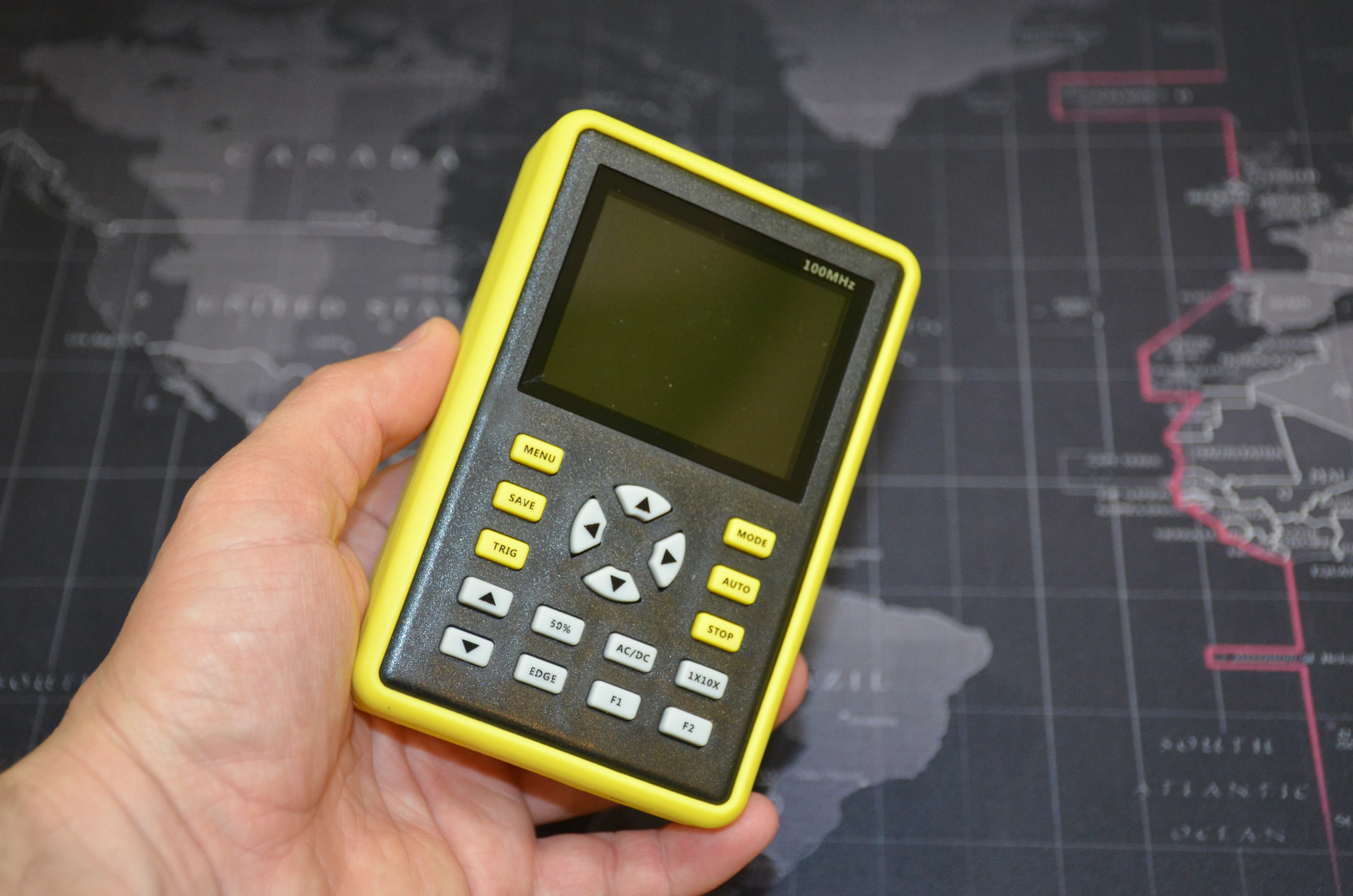
So, the main technical characteristics of handheld oscilloscopes are the operating band, which is measured in MHz, as well as the sampling frequency, which directly affects the quality of measurements.
In the article I will try to describe the oscilloscopes that were personally in my hands and give small advantages and disadvantages of these models.
The initial option, through which many hams passed, is an oscilloscope based on the ATmega microcontroller, there are many options on Ali, including for self-assembly, for example, DSO138. Its development based on the STM32 microcontroller is called DSO150.
DSO150 Oscilloscope- This is a good oscilloscope for an entry-level amateur radio amateur. Included is a P6020 probe. The oscilloscope itself has a bandwidth of about 200 kHz. Built on the basis of STM32, ADC up to 1M samples. A good option for checking simple power supplies (PWM) and audio paths. Suitable for beginners, for example, to study sound signals (tuning an amplifier, etc.). Of the minuses, I note the inability to save the image of the waveform, as well as a small bandwidth.

Specifications:
If desired, you can find even cheaper not soldered option. Suitable for training soldering "with meaning".
But the hobby quickly passed, switched to serious models.
At the beginning of 2018, one of the most popular entry-level oscilloscopes came across - a simple but good oscilloscope probe - DSO188.
The DSO188 is a simple “display” with one channel, no memory, but with a color display, 300mAh battery and very small in size. Its plus is in compactness and portability, and the frequency band is enough for most applications (for example, tuning audio equipment).
At a low cost ($ 30), it displays signals with a frequency of 1 MHz (5MSA / s sampling). MMCX probes are used for operation, but the kit includes an MMCX-BNC adapter. A separate ADC is installed on 5MSPS, a band up to 1 MHz, a prefabricated case made of panels, which looks very good. In the pluses, I note the compact size and decent band, compared with the DSO150 (1MHz), as well as compact dimensions. It is very convenient to use together with a conventional tester. Easy to fit in your pocket. Of the minuses - the case has an open design, not protected from external influences (you need to modify it), as well as the lack of the ability to transfer saved images to a computer. The presence of the MMCX connector is convenient, but for full operation you will need an adapter for BNC or special probes. For the money, this is a very good entry-level option.

Specifications:

If one megahertz is not enough, you can look towards handheld oscilloscopes in a case with a BNC connector, for example, the inexpensive handheld oscilloscope DSO FNISKI PRO.
This is a very good option for the money. 5 MHz band (sine). It is possible to save graphs to the internal memory of the device.
Specifications:

There is a variant DSO FNISKI PRO with BNC crocodiles.

There is a DSO FNISKI PRO option with a 10x P6010 probe (with a band up to 10MHz).
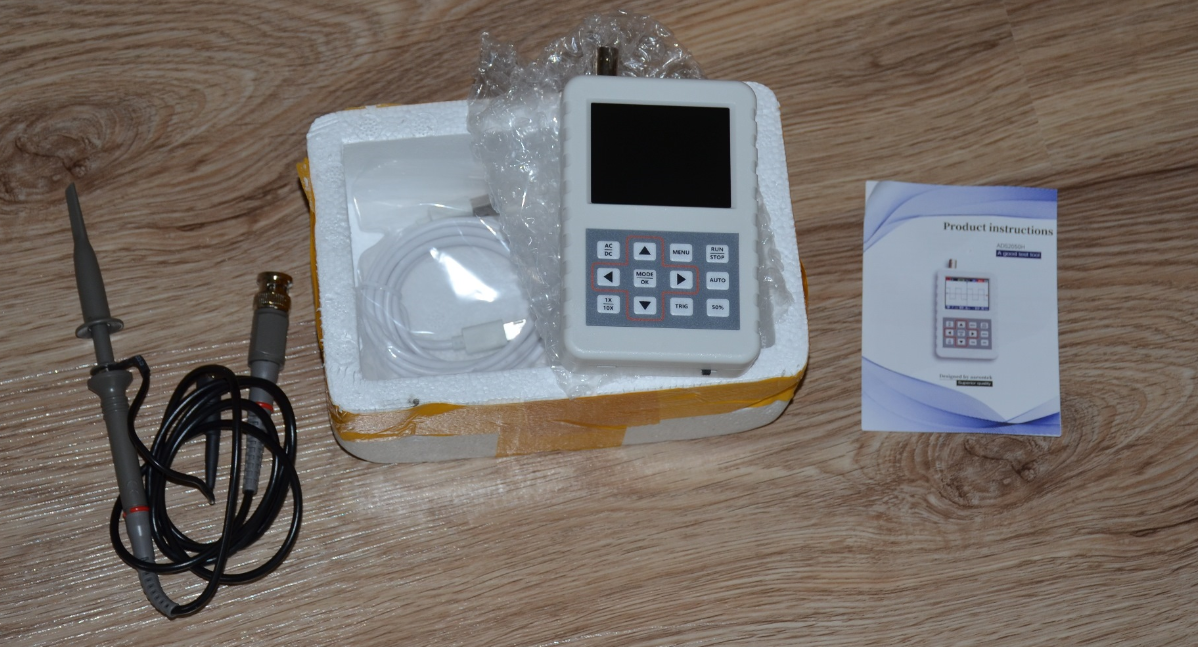
I would take the first option (with crocodiles) and buy additional probes separately. A link to the probes is below.
According to the results of use, I note a convenient housing, a large display. The test signal at 5 MHz (sine) shows without any problems, other periodic and aperiodic signals normally show up to 1 MHz.
If the band above 1 MHz is not critical, and you do not need to work with high voltages, then the DSO FNIRSI PRO with a BNC connector is a good choice. It uses standard probes and can be used as a quick pocket oscilloscope probe - poke and see if the exchange is alive, microcircuit, etc. And then stomp for a large oscilloscope, or carry the patient to the table and open it.
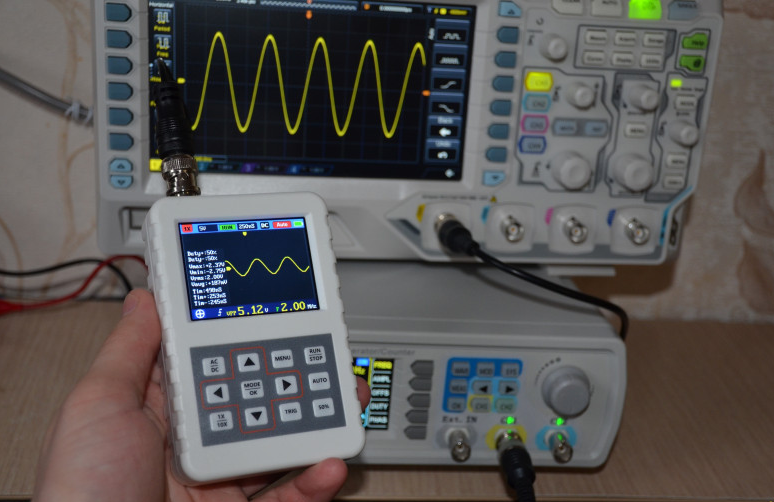
But if you need a strip even a little more - pay attention to the inexpensive DSO168 oscilloscope probe. The DSO168
oscilloscope has an unusual design that looks like popular MP3 players. This is both a plus (a stylish metal case) and a minus device. Not the most successful connector choice - MiniUSB for charging the battery. And also I note the connection via a 3.5 mm jack - the most important minus of this model.
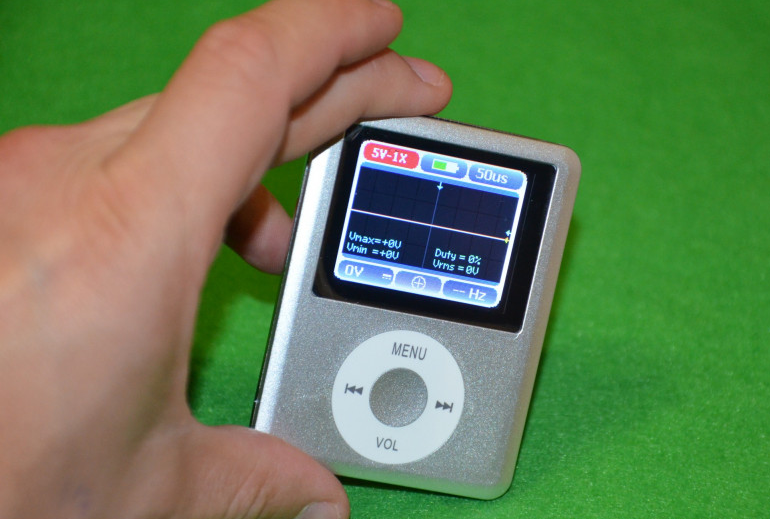
Specifications:
DSO168 is an interesting device for its price.
Much better than a huge number of similar DSO138, which are built on the basis of microcontrollers with integrated ADC (200kHz).
In this DSO168 model, a separate AD9283 ADC is installed, which provides reliable signal analysis up to 1 MHz. Up to 8 MHz, you can use this device, but as a “mapper” of signals, without any serious measurements. But up to 1 MHz - no problem.
The kit comes with a standard P6100 BNC probe, as well as an adapter from a 3.5mm jack to BNC.
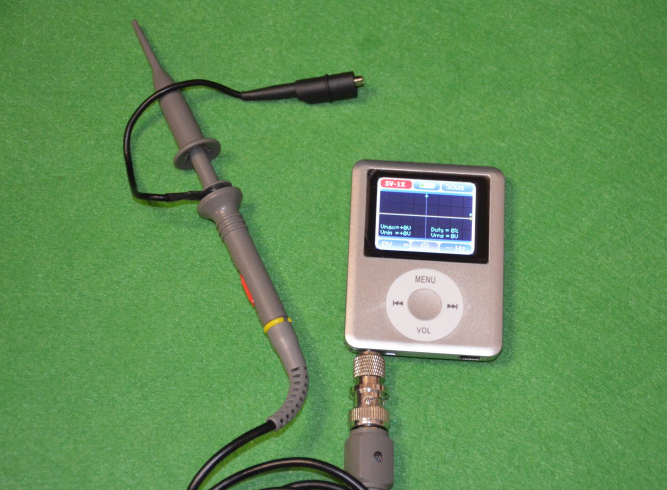
The DSO168 oscilloscope has a 20 MHz band (at a sampling frequency of 60MSA / s), not the most successful, but more or less neat iPod case, built-in 800 mAh battery (can be powered by USB). Similarity with the player is added by probes through a 3.5 mm jack (there is a BNC-3.5mm adapter). There is no memory to save waveforms. I note a constructive miscalculation - the 3.5 mm jack is not designed to transmit microwave signals, there are distortion of the waveform at frequencies above 1 MHz. So the device is interesting, but I would choose another option.
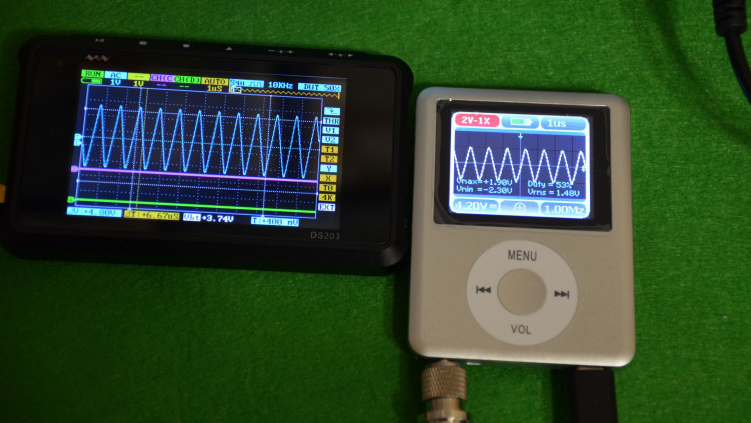
Next, I propose to see another inexpensive model of the DSO338 oscilloscope with a 30 MHz band.
Pocket Oscilloscope DSO 338 FNISKI 30MHZ
This is a pocket-sized battery oscilloscope for one channel with a sampling frequency of as much as 200Msps. The characteristics are not bad, many of this model is enough for the eyes. In the presence of one channel, the display has good viewing angles, up to 8 hours of battery life per charge continuously.
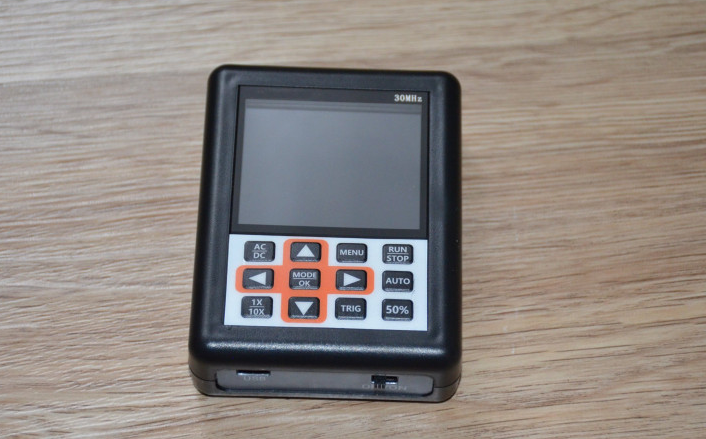
Specifications:
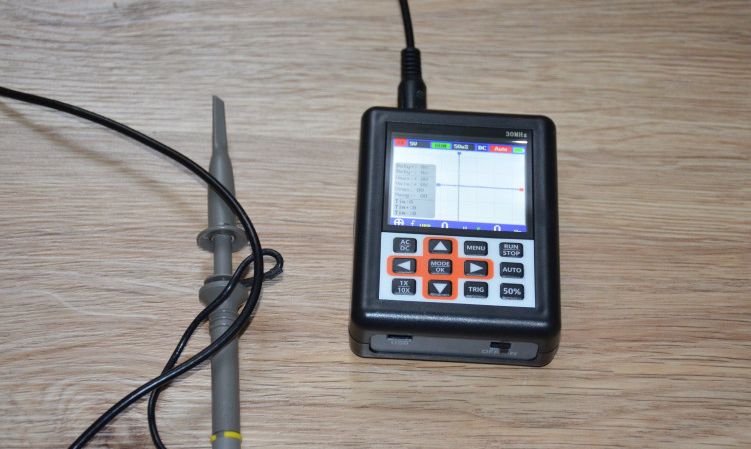
For measurements, the standard probe P6100 BNC is used.
The oscilloscope shows itself quite well at frequencies above 10-20 MHz.
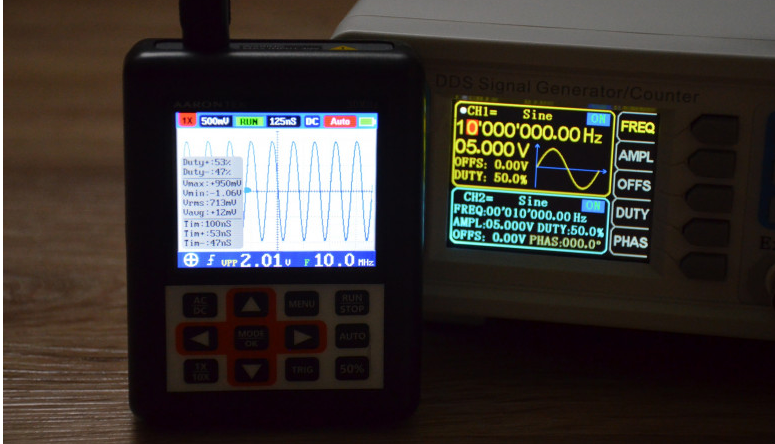
A good option, but given its cost, you can see other models.
For example, you can buy a powerful oscilloscope FNIRSI-5012H 100 MHz a little more expensive . A
new model and one of the best for the money - a single-channel 100-MHz oscilloscope with memory. Sampling frequency reaches 500 Msps.
The oscilloscope is one of the most powerful and sophisticated in its price range. There is 1 BNC channel, but the oscilloscope can display a sinusoidal signal up to 100MHz. Other periodic and aperiodic signals look normal up to 70-80 MHz.
Included with the oscilloscope is a good P6100 probe with a 10x divider and a band of up to 100 MHz, as well as a case for storage and carrying.
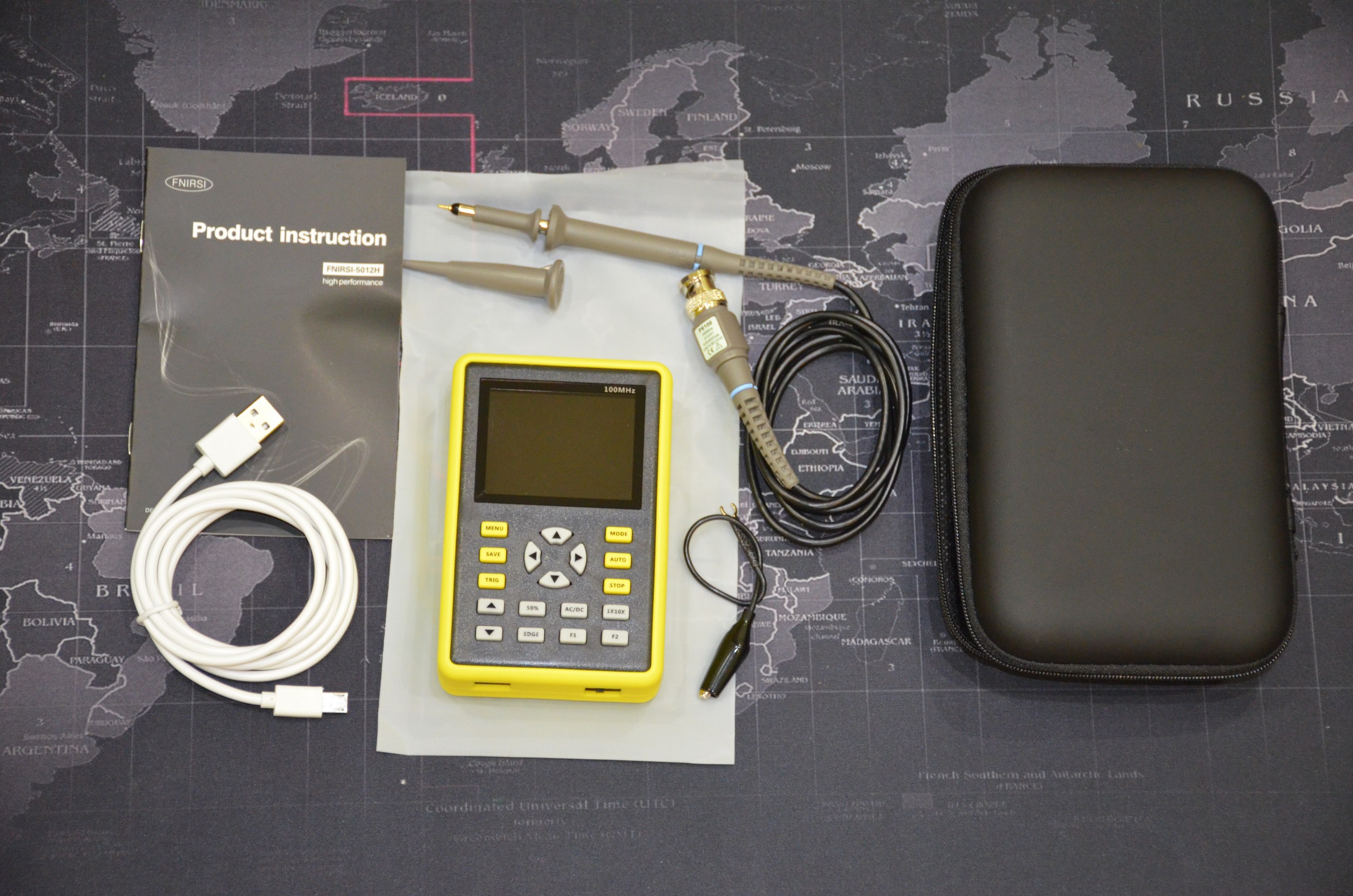
Specifications:
The oscilloscope copes with the signals no worse than the older brother of Rigol.

I note the lack of communication with the computer (this is partly not a minus, since there is no need to carry out galvanic isolation), as well as the presence of only one channel for measurement.
DSO Fniski 100MHz is a good choice, especially if there is no suitable device and the cost issue is acute. If there is an opportunity to add, it is better to add and take something into two channels and with the ability to save the results.
HANTEK 2C42
40 MHz portable 3-in-1 oscilloscope Hit of the year 2019 - a portable oscilloscope with a frequency of 40 MHz (there is a 2C72 model up to 70 MHz) on two channels and with a frequency generator. Built-in multimeter. Comes with a carrying bag. Price from $ 99.
The kit has everything you need + carrying case. Digitization rates up to 250MSa / s are the best result for portable oscilloscopes. There are versions 2C42 / 2C72 without a built-in generator, but they are not so interesting in terms of price and functionality.

Specifications:
The oscilloscope is slightly more expensive than the previous ones, but the 2Dx2 model is equipped with a frequency generator. The photo below shows the generation of a sinusoidal signal with a frequency of 1 MHz.
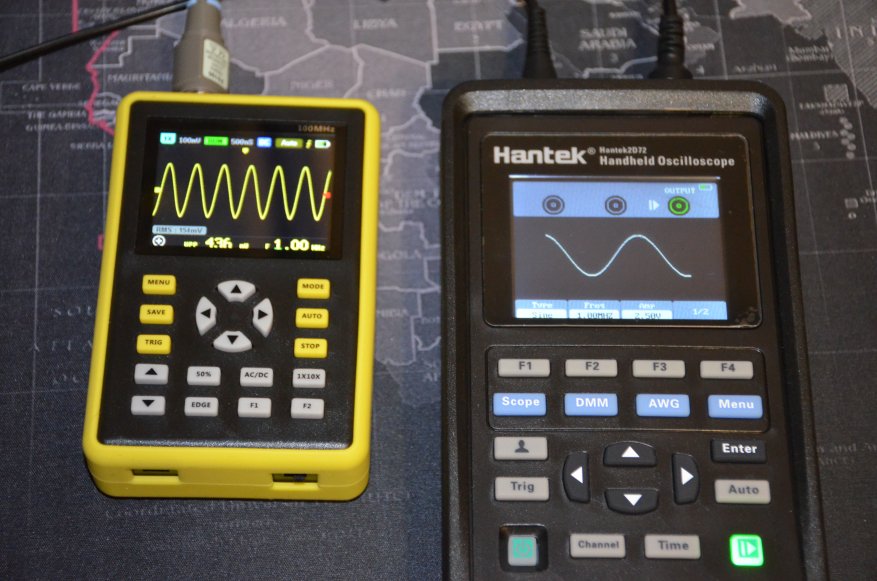
Otherwise, Hantek is no worse than its older counterparts. I note the presence of a built-in multimeter, which makes this model a 3-in-1 device.
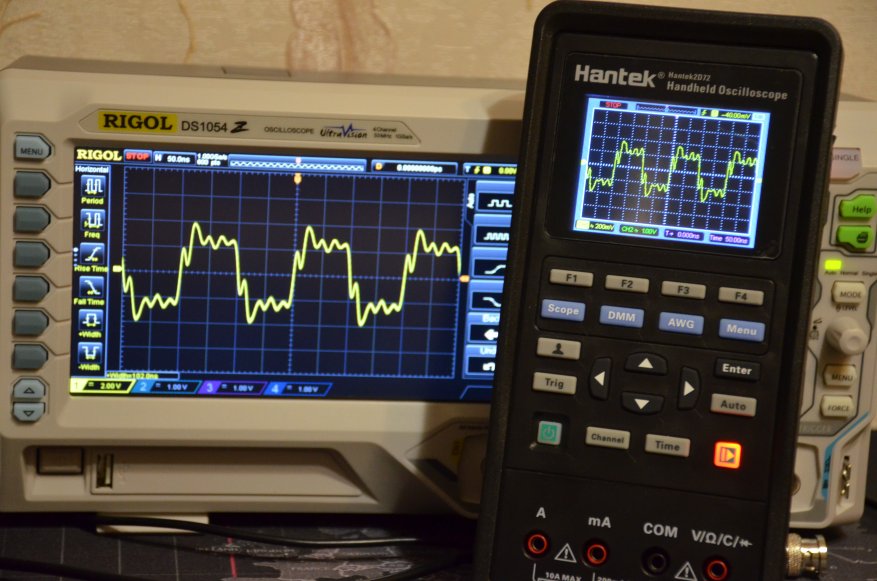
The oscilloscopes that I have run out of, but I will mention another model that has the right to life. In this price range there is a convenient and high - quality model of the portable oscilloscope JDS6031 1CH 30M 200MSPS .
Specifications:
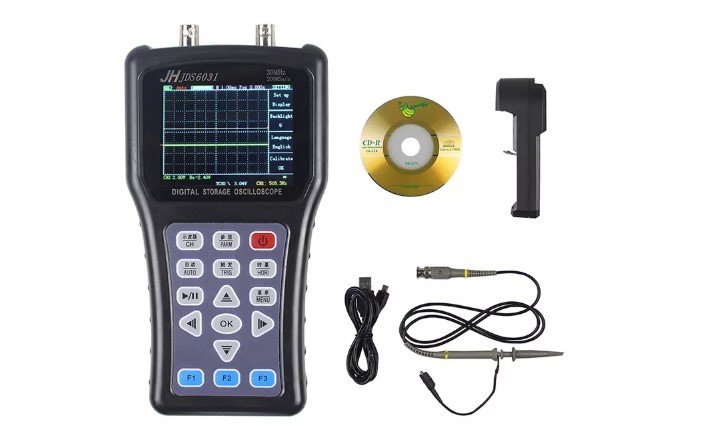
I recommend paying attention to useful accessories for the oscilloscope:
P6100 100MHz probe with capacitance compensation and a 10x divider ($ 5)
100MHz P2100 probe with capacitance compensation and a 10x divider Copy of Tectronix ($ 7)
P4100 100MHz 2kV probe with capacitance compensation and a 100x divider ($ 10)
Passive attenuator Hantek HT201 signal for 20: 1 BNC oscilloscope for voltage measurements up to 800V ($ 4)
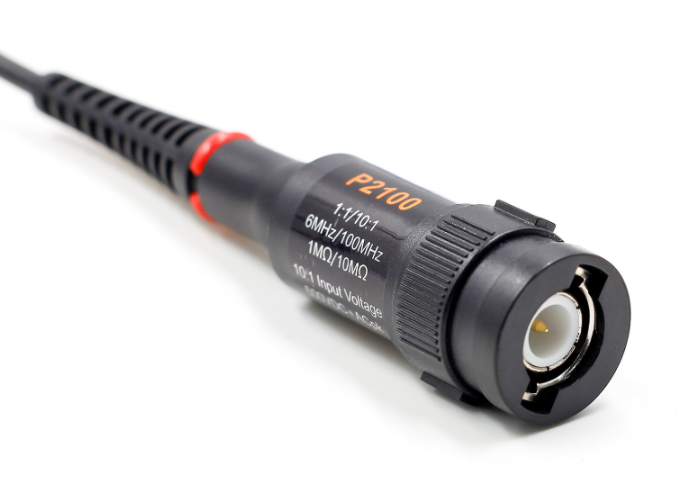
Such portable devices are what I often use. It is very convenient, especially when setting up various devices, checking, commissioning. I can recommend taking the DSO150 variant, or even better, the similar DSO138 (200kHz) in the DIY variant for teaching soldering and the basics of radio electronics. Among the functional models, I note the DSO Fniski 100MHz, as an oscilloscope with the best price / operating band ratio, and the Hantek 2D72 as the most functional (3-in-1).
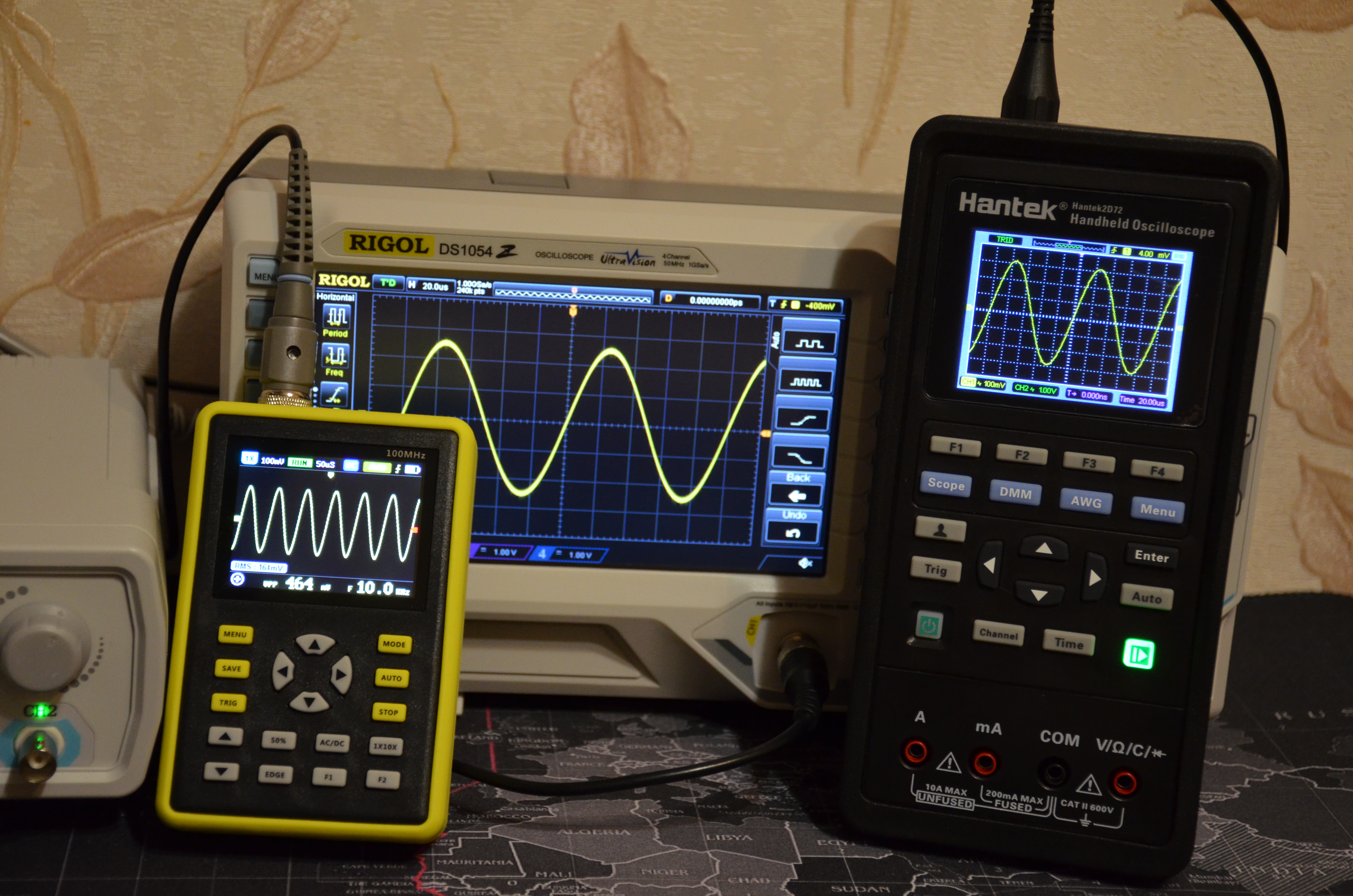
I’m adding a short article on the topic of choosing an entry-level home compact oscilloscope for work and hobbies.
Why it will be about pocket and compact - because these are the most budget options. Desktop oscilloscopes are more bulky, functional devices, and, as a rule, quite expensive models ($ 200-400 and more expensive) for 4 channels with many functions.
But compact models for 1 channel for simple measurements and evaluation of the waveform can be purchased literally for $ 20 ... $ 40.

So, the main technical characteristics of handheld oscilloscopes are the operating band, which is measured in MHz, as well as the sampling frequency, which directly affects the quality of measurements.
In the article I will try to describe the oscilloscopes that were personally in my hands and give small advantages and disadvantages of these models.
The initial option, through which many hams passed, is an oscilloscope based on the ATmega microcontroller, there are many options on Ali, including for self-assembly, for example, DSO138. Its development based on the STM32 microcontroller is called DSO150.
DSO150 Oscilloscope- This is a good oscilloscope for an entry-level amateur radio amateur. Included is a P6020 probe. The oscilloscope itself has a bandwidth of about 200 kHz. Built on the basis of STM32, ADC up to 1M samples. A good option for checking simple power supplies (PWM) and audio paths. Suitable for beginners, for example, to study sound signals (tuning an amplifier, etc.). Of the minuses, I note the inability to save the image of the waveform, as well as a small bandwidth.

Specifications:
- Real-time Sampling Rate: 1 MSa / s
- Analog bandwidth: 0 - 200 kHz
- Sensitivity Range: 5 - 20 mV / div
- Maximum input voltage: 50 V max. (1x probe)
- Sweep time range: 500 s / div– 10 μs / div
If desired, you can find even cheaper not soldered option. Suitable for training soldering "with meaning".
But the hobby quickly passed, switched to serious models.
At the beginning of 2018, one of the most popular entry-level oscilloscopes came across - a simple but good oscilloscope probe - DSO188.
The DSO188 is a simple “display” with one channel, no memory, but with a color display, 300mAh battery and very small in size. Its plus is in compactness and portability, and the frequency band is enough for most applications (for example, tuning audio equipment).
At a low cost ($ 30), it displays signals with a frequency of 1 MHz (5MSA / s sampling). MMCX probes are used for operation, but the kit includes an MMCX-BNC adapter. A separate ADC is installed on 5MSPS, a band up to 1 MHz, a prefabricated case made of panels, which looks very good. In the pluses, I note the compact size and decent band, compared with the DSO150 (1MHz), as well as compact dimensions. It is very convenient to use together with a conventional tester. Easy to fit in your pocket. Of the minuses - the case has an open design, not protected from external influences (you need to modify it), as well as the lack of the ability to transfer saved images to a computer. The presence of the MMCX connector is convenient, but for full operation you will need an adapter for BNC or special probes. For the money, this is a very good entry-level option.

Specifications:
- Real-time Sampling Rate: 5 MSa / s
- Analog Bandwidth: 0 - 1 MHz
- Sensitivity Range: 50 mV / div ~ 200 V / div
- Maximum input voltage: 40 V (1X probe), 400 V (10X probe). There is no built-in attenuator.
- Sweep Time Range: 100mS / div ~ 2uS / div

If one megahertz is not enough, you can look towards handheld oscilloscopes in a case with a BNC connector, for example, the inexpensive handheld oscilloscope DSO FNISKI PRO.
This is a very good option for the money. 5 MHz band (sine). It is possible to save graphs to the internal memory of the device.
Specifications:
- Real-time Sampling Rate: 20 MSa / s
- Analog Bandwidth: 0 - 5 MHz
- Sensitivity Range: 50 mV / div ~ 200 V / div
- Maximum input voltage: 40 V (1X probe), 400 V (10X probe). There is no built-in attenuator.
- Sweep Time Range: 50S / div ~ 250nS / div

There is a variant DSO FNISKI PRO with BNC crocodiles.

There is a DSO FNISKI PRO option with a 10x P6010 probe (with a band up to 10MHz).

I would take the first option (with crocodiles) and buy additional probes separately. A link to the probes is below.
According to the results of use, I note a convenient housing, a large display. The test signal at 5 MHz (sine) shows without any problems, other periodic and aperiodic signals normally show up to 1 MHz.
If the band above 1 MHz is not critical, and you do not need to work with high voltages, then the DSO FNIRSI PRO with a BNC connector is a good choice. It uses standard probes and can be used as a quick pocket oscilloscope probe - poke and see if the exchange is alive, microcircuit, etc. And then stomp for a large oscilloscope, or carry the patient to the table and open it.

But if you need a strip even a little more - pay attention to the inexpensive DSO168 oscilloscope probe. The DSO168
oscilloscope has an unusual design that looks like popular MP3 players. This is both a plus (a stylish metal case) and a minus device. Not the most successful connector choice - MiniUSB for charging the battery. And also I note the connection via a 3.5 mm jack - the most important minus of this model.

Specifications:
- Real-time Sampling Rate: 50 MSa / s
- Analog Bandwidth: 0 - 20 MHz
- Sensitivity Range: 50 mV / div ~ 200 V / div
- Maximum input voltage: 40 V (1X probe)
- Sweep Time Range: 100S / div ~ 100nS / div
DSO168 is an interesting device for its price.
Much better than a huge number of similar DSO138, which are built on the basis of microcontrollers with integrated ADC (200kHz).
In this DSO168 model, a separate AD9283 ADC is installed, which provides reliable signal analysis up to 1 MHz. Up to 8 MHz, you can use this device, but as a “mapper” of signals, without any serious measurements. But up to 1 MHz - no problem.
The kit comes with a standard P6100 BNC probe, as well as an adapter from a 3.5mm jack to BNC.

The DSO168 oscilloscope has a 20 MHz band (at a sampling frequency of 60MSA / s), not the most successful, but more or less neat iPod case, built-in 800 mAh battery (can be powered by USB). Similarity with the player is added by probes through a 3.5 mm jack (there is a BNC-3.5mm adapter). There is no memory to save waveforms. I note a constructive miscalculation - the 3.5 mm jack is not designed to transmit microwave signals, there are distortion of the waveform at frequencies above 1 MHz. So the device is interesting, but I would choose another option.

Next, I propose to see another inexpensive model of the DSO338 oscilloscope with a 30 MHz band.
Pocket Oscilloscope DSO 338 FNISKI 30MHZ
This is a pocket-sized battery oscilloscope for one channel with a sampling frequency of as much as 200Msps. The characteristics are not bad, many of this model is enough for the eyes. In the presence of one channel, the display has good viewing angles, up to 8 hours of battery life per charge continuously.

Specifications:
- Real-time Sampling Rate: 200 MSa / s
- Analog Bandwidth: 0 - 30 MHz
- Sensitivity Range: 50 mV / div ~ 200 V / div
- Maximum input voltage: 40 V (1X probe), 400 V (10X probe). There is no built-in attenuator.
- Sweep Time Range: 100mS / div ~ 125nS / div

For measurements, the standard probe P6100 BNC is used.
The oscilloscope shows itself quite well at frequencies above 10-20 MHz.

A good option, but given its cost, you can see other models.
For example, you can buy a powerful oscilloscope FNIRSI-5012H 100 MHz a little more expensive . A
new model and one of the best for the money - a single-channel 100-MHz oscilloscope with memory. Sampling frequency reaches 500 Msps.
The oscilloscope is one of the most powerful and sophisticated in its price range. There is 1 BNC channel, but the oscilloscope can display a sinusoidal signal up to 100MHz. Other periodic and aperiodic signals look normal up to 70-80 MHz.
Included with the oscilloscope is a good P6100 probe with a 10x divider and a band of up to 100 MHz, as well as a case for storage and carrying.

Specifications:
- Real-time Sampling Rate: 500 MSa / s
- Analog Bandwidth: 0 - 100 MHz
- Sensitivity Range: 50 mV / div ~ 100 V / div
- Maximum input voltage: 80 V (1X probe), 800 V (10X probe). There is no built-in attenuator.
- Sweep Time Range: 50S / div ~ 6nS / div
The oscilloscope copes with the signals no worse than the older brother of Rigol.

I note the lack of communication with the computer (this is partly not a minus, since there is no need to carry out galvanic isolation), as well as the presence of only one channel for measurement.
DSO Fniski 100MHz is a good choice, especially if there is no suitable device and the cost issue is acute. If there is an opportunity to add, it is better to add and take something into two channels and with the ability to save the results.
HANTEK 2C42
40 MHz portable 3-in-1 oscilloscope Hit of the year 2019 - a portable oscilloscope with a frequency of 40 MHz (there is a 2C72 model up to 70 MHz) on two channels and with a frequency generator. Built-in multimeter. Comes with a carrying bag. Price from $ 99.
The kit has everything you need + carrying case. Digitization rates up to 250MSa / s are the best result for portable oscilloscopes. There are versions 2C42 / 2C72 without a built-in generator, but they are not so interesting in terms of price and functionality.

Specifications:
- Real-time Sampling Rate: 250 MSa / s
- Analog Bandwidth: 0 - 40 MHz
- Sensitivity Range: 10 mV / div ~ 10 V / div
- Maximum input voltage: 60 V (1X probe), 600 V (10X probe).
- Sweep Time Range: 500S / div ~ 5nS / div
The oscilloscope is slightly more expensive than the previous ones, but the 2Dx2 model is equipped with a frequency generator. The photo below shows the generation of a sinusoidal signal with a frequency of 1 MHz.

Otherwise, Hantek is no worse than its older counterparts. I note the presence of a built-in multimeter, which makes this model a 3-in-1 device.

The oscilloscopes that I have run out of, but I will mention another model that has the right to life. In this price range there is a convenient and high - quality model of the portable oscilloscope JDS6031 1CH 30M 200MSPS .
Specifications:
- Real-time Sampling Rate: 200 MSa / s
- Analog Bandwidth: 0 - 30 MHz
- Sensitivity Range: 10 mV / div ~ 10 V / div
- Maximum input voltage: 60 V (1X probe), 600 V (10X probe).
- Sweep Time Range: 500S / div ~ 5nS / div

I recommend paying attention to useful accessories for the oscilloscope:
P6100 100MHz probe with capacitance compensation and a 10x divider ($ 5)
100MHz P2100 probe with capacitance compensation and a 10x divider Copy of Tectronix ($ 7)
P4100 100MHz 2kV probe with capacitance compensation and a 100x divider ($ 10)
Passive attenuator Hantek HT201 signal for 20: 1 BNC oscilloscope for voltage measurements up to 800V ($ 4)

Such portable devices are what I often use. It is very convenient, especially when setting up various devices, checking, commissioning. I can recommend taking the DSO150 variant, or even better, the similar DSO138 (200kHz) in the DIY variant for teaching soldering and the basics of radio electronics. Among the functional models, I note the DSO Fniski 100MHz, as an oscilloscope with the best price / operating band ratio, and the Hantek 2D72 as the most functional (3-in-1).

